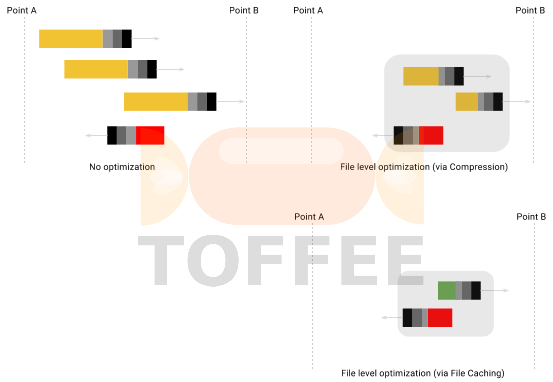RESEARCH 》 CDN Content Delivery Networks - Types
Internet based CDN: Internet based CDN the CDN Services provider will place 100s of CDN caching nodes across the internet (usually in ISPs), and serving the end-user content requests directly from these CDN nodes instead from the main origin web-server(s) of the website.
Private CDN: There can be multiple types of CDN infrastructure, such as CDN service provider Networks/Infrastructure (discussed mostly so far) where end-users or customers rent their infrastructure via their paid services. And in another case a company can build their own company’s proprietary private CDN infrastructure where a company builds it and uses for their own services (for example infrastructure of Google), then a hybrid of both where there can be an interconnected CDN service provider’s network and proprietary CDN.
Sometimes these private CDN Networks can be built from scratch from their own built from scratch tools and infrastructure, and sometimes they can use other
third-party tools and platform to build the same. In either case, simply put private CDN is the private built CDN built for the purpose of its own firm.
It is not a CDN service provider infrastructure.
The main advantages of private CDN is the data security. Since it is 100% private infrastructure,
the data and all the resources are available in the company’s owned machines. Hence sometimes depending on the requirement where there is huge traffic and also
a need to highly secure this data, sometimes it is necessary to build an organization’s own private CDN either with technology built by them, or either buying
CDN building tools from third party CDN Software/tool vendors. Hence sometimes any CDN Service provider, can also build these tools/software/hardware and so on,
and can sell to their customers to enable them to build their own 100% private CDN infrastructure.
Peer-to-Peer (P2P) CDN: We know Peer-to-peer (P2P) technology is widely used in bulk file downloads via torrents. Unfortunately most people often relate
P2P with respect to illegal data/file sharing. These days more and more large software downloads are available via P2P technology. This even includes several
official ISO Linux Distribution Download formats.
So a CDN based on peer-to-peer (P2P) technology can be built to achieve this goal. Services
like Napster, and the infamous Pirate Bay and so on, made headlines after being sued by major recording industry and movie industry corporations that claimed
the file sharing services violated their copyright. Nevertheless, the technology itself is legal and very useful for practical file distribution and in this
case as a core CDN objective (such as load-sharing, content distribution, redundancy, and so on). So even large companies like AT&T to non-profit university
libraries rely on P2P content distribution.
P2P itself is not one type of technology but rather refers to several types of protocols, including
Gnutella, BitTorrent, and and FastTrack protocols. CDN Networks can use P2P to distribute a website’s content without needing to cache the content on other
dedicated servers (as in the case of traditional Internet based CDN scenario). Instead, the users accessing the site share in the distribution of the content,
without any adverse effects on their experiences.
Because a P2P CDN requires less power and hardware from the CDN service itself, many P2P CDNs offer
their services for free. Websites that want to participate usually need to append the service’s URL to their content URLs or add certain code to their websites.
How to check a website using CDN? If you are looking ways to find a website is using a CDN, you can follow this guide HERE. This way you can know if the website is using any CDN service and its corresponding CDN vendor(s) providing the subscription(s) services.
Suggested Topics:
Generic CDN
Building my own CDN
| 💎 TOFFEE-MOCHA new bootable ISO: | Download |
| 💎 TOFFEE Data-Center Big picture and Overview: | Download PDF |

Saturday' 13-Mar-2021
Featured Educational Video:

Saturday' 13-Mar-2021
Research :: Optimization of network data (WAN Optimization) at various levels:

Learn Linux Systems Software and Kernel Programming:
![Linux, Kernel, Networking and Systems-Software online classes [CDN] Linux, Kernel, Networking and Systems-Software online classes [CDN]](http://sareesaremypassion.org/cdn/the-toffee-project/i/the_linux_channel_banner2.jpg)
Hardware Compression and Decompression Accelerator Cards:
![TOFFEE Architecture with Compression and Decompression Accelerator Card [CDN] TOFFEE Architecture with Compression and Decompression Accelerator Card [CDN]](http://sareesaremypassion.org/cdn/the-toffee-project/i/DOCUMENTATION/33/TOFFEE%20compression%20hardware.png)
TOFFEE-DataCenter on a Dell Server - Intel Xeon E5645 CPU:







